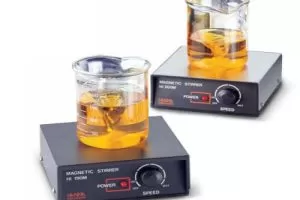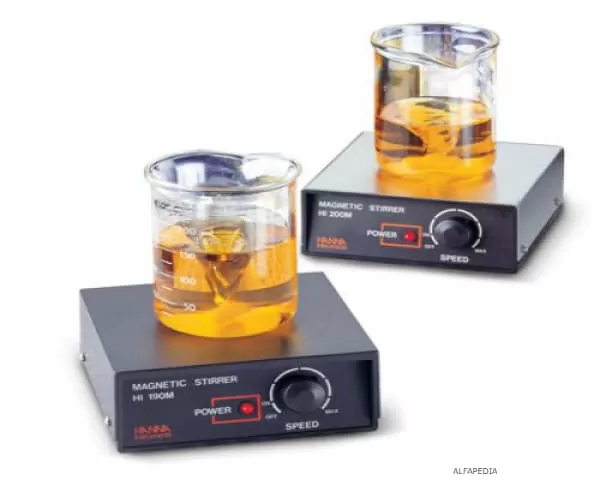Definition of the Magnetic Stirrer
It is a machine that produces a rotating magnetic field, so that a magnetic stirring bar will automatically stir a chemical solution. They often incorporate an electric heating plate.
History and Origin of the Magnetic Agitator
Even after a century of technological advancement, today’s laboratory stirrers still look like the original design. An electric field under the base plate oscillates causing the magnetic stirring bar to rotate. The agitator evolved rapidly once it reached the market. Integration with a heating plate was a bold step towards laboratory automation.
1939: Heating is added to the stirrer.
1944: Glass, porcelain and plastic coatings are added to prevent the agitator from compromising solutions.
Balancing is another gentle method of agitation that performs membrane-based tests and washes. Agitation is a more vigorous method of mixing than either agitation or rolling. Increased agitation also has a secondary benefit: oxygenating samples. This is particularly useful in biological studies. These advances in automatic agitation freed up researchers to explore biological processes, creating demand for even more vigorous mixing and aeration.
In the mid-20th century, great advances were made in isolating and culturing bacteria. Graduate students at Rutgers University were engaged in isolating an antibiotic-producing bacteria, but achieved inconsistent results. They identified their makeshift test tube agitator as the weak link in their process chain. The stirring device that responded to that need was used in the isolation of Nobel Prize-winning streptomycin.
1949: Rutgers University worked with manufacturers to develop the first stirring device.
1952: Nobel Prize awarded for effective use of streptomycin against tuberculosis.
Shakers were used for 20 years before researchers fully understood the implications of shaking in the fields of bioengineering and biochemical processes. The parameters were now documented for agitator speed, orbital diameter and flask angle.
1960: The focus on oxygenation led to advances in mammalian cell culture.
What is the Magnetic Stirrer ?
A magnetic stirrer or magnetic mixer is a laboratory device that uses a rotating magnetic field to make a stirring rod immersed in a liquid rotate very quickly, stirring it. The rotating field can be created by a rotating magnet or a set of stationary electromagnets, placed under the vessel with the liquid.
As the glass does not affect the magnetic field appreciably and most chemical reactions take place in glass containers, magnetic stirring bars work well in glass containers. On the other hand, the limited size of the bar means that magnetic stirrers can only be used for relatively small experiments.
They also have difficulties in dealing with viscous liquids or thick suspensions. For larger volumes or more viscous liquids, some form of mechanical agitation is usually required. Magnetic stirrers are often used in chemistry and biology. They are preferred to motorised agitators with gears because they are quieter, more efficient and have no external moving parts to break or wear out.
Due to its small size, a stirring bar is easier to clean and sterilize than other stirring devices. They do not require lubricants that can contaminate the reaction vessel and the product. They can be used inside hermetically sealed containers or systems, without the need for complicated rotary seals. Magnetic stirrers may also include a hot plate or other means of heating the liquid.
What is the Magnetic Stirrer Used For ?
- A magnetic stirrer is a device widely used in laboratories and consists of a rotating magnet or a stationary electromagnet that creates a rotating magnetic field.
- This device is used to make a stirring rod, immerse it in a liquid, rotate quickly or stir or mix a solution, for example. A magnetic stirring system usually includes a heating system coupled to heat the liquid.
- Most of today’s magnetic stirrers rotate the magnets by means of an electric motor. This type of equipment is one of the simplest for preparing mixtures.
- Magnetic stirrers are quiet and offer the possibility of stirring closed systems without the need for insulation, as is the case with mechanical stirrers.
The Use of the Magnetic Agitator
- The stirring bar is the magnetic bar that is immersed in the liquid to provide the stirring action. Stirring bars are generally coated with Teflon or glass to be chemically inert so that they cannot contaminate or react with the reaction mixture in which they are found.
- The basic model of the bar is octagonal or circular, although there are other special shapes for more efficient stirring.
- The magnetic stirrer usually has a capacity of four (4) liters or less due to its small size, so they are used for relatively small experiments.
- On the other hand, stirring bars do not work properly with viscous liquids or thick suspensions. However, one of the advantages is that the cleaning and sterilization process is easy.
- The magnetic stirring equipment allows for variable speed stirring according to the requirement.
- It is advisable to use gentle rather than violent agitation, taking into account not only agitation of the liquid culture medium and exposure of the cells to the gas on the surface, but also to avoid damage to the cell.
- On the other hand, the fluid often changes in the viscosity of the medium, either increasing or decreasing.
- These changes sometimes cannot be easily detected, so it is advisable to measure the sample to detect changes. Some devices can alert to these changes, but most magnetic stirrers cannot.
- A magnetic stirrer has the ability to perform all relevant tasks in the background while dealing with the most urgent and important issues.
- An example of its use is to make a shower gel.
How to Make a Shower Oil ?
Formulation:
Phase A
Dermofeel G5O 6.0%
Organic glycerin, 99% 30.0%
Phase B
Organic Camelina Oil 52.4%
Lexfeel natural 10.0%
alpha-tocopherol 0.5%
Rosemary CO2 extract 0.1%
Petitgrain EO 0.5%
Blood Orange EO 0.5%
Procedure:
- 1- Mix phases A and B separately in two beakers. We have used the magnetic stirrer for this purpose.
- It is possible that the viscosity of phase A is too high for your magnetic stirrer (especially in winter). In this case, use a spatula to thoroughly mix the glycerine and emulsifier.
- 2- Slowly add the oil phase to the glycerine phase while stirring the glycerine phase.
- At first, you may need to mix with a spatula to fully incorporate the oil into the glycerine phase. As you proceed with the addition, the viscosity is reduced and mixing becomes easier. Wait for a complete mix before each addition.
- 3- As all the oil phase is added to the glycerine phase, continue to mix gently for a few minutes. Fill a bottle or a suitable tube.
One of the longest procedures in the cosmetic laboratory is to make oleogels with Dermofeel G5O. This requires the slow addition of the oil phase to the emulsifier-glycerine phase while stirring the glycerine phase. Using a magnetic stirrer for this procedure does not make things much faster, but at least it saves a lot of muscle energy and exercise.
How Does the Magnetic Stirrer work ?
- The magnetic stirrer is essentially a small bar magnet and a holder containing a rotating magnet. The bar magnet is usually in a plastic casing and a stand or place holds the rotating magnet.
- Therefore, this configuration helps to create a rotating magnetic field.
- The magnetic stirrer has several applications and is actively used in many different industries. The main tasks it performs are stirring or mixing fluid samples. This is very useful in the food and chemical industry; in addition, it is also used in several other industries such as biotechnology.
- A magnetic stirrer is often also known as a magnetic stirring plate. Several companies and people who often perform chemical and biological experiments find these magnetic stirrers.
If you have a requirement that sample components must be mixed, a magnetic stirrer is the right device for you. - It is possible to use liquid or solid samples to obtain a homogeneous liquid mixture. For example, bacterial growth medium is one type of sample used with the magnetic stirrer.
- The way the magnetic stirrer works is that an external magnetic field is applied to the mixing solution in the magnetic stirrer. This happens when the sample you have placed in the shaker starts to spin with the small bar magnet.
- The magnetic stirrer is a fairly small device and therefore very easy to use in a laboratory.
- A magnetic stirrer plays an important role in minimising the risk of contamination, as there is only one inert bar magnet that is placed inside the sample (fluid). It is very easy to keep this device clean.
- A manual stirrer is different from a magnetic stirrer. The magnetic stirrer is vital for the reproducible mixing process or mixing over a long period of time.
- In the event that you require the protein dialysis process to be performed on a sample, you will need to place the sample in the shaker for a long time. In fact, many laboratories prefer to mix samples overnight, which allows them to use valuable time.
- This would be possible only with a magnetic stirrer and not the manual type.
Characteristics of the Magnetic Stirrer
Capacity
The capacity of the agitator is always mentioned for water. It is mentioned for the Max. capacity: 4 litres, for example. The nominal capacity is much higher than the actual capacity because obviously running water is rarely used for stirring. The mini models have a capacity of 3 litres and are quite competent for at least 1 litre of surfactant solution and about 250 ml of an emulsion.
Max. speed
The speed is expressed as rpm (rotations per minute). They in. The speed is approximately 1000 rpm. Powerful models have a speed of up to 2500 rpm. Everything between 1000-1500 rpm should be fine for your lab.
Max. permitted temperature and humidity
If you work in a wet lab and your lab is located in tropical regions, or you intend to mix hot material, please take a look at the maximum permissible working temperature and humidity of the instrument before purchasing yours.
Dimensions of the mounting surface
The surface area obviously defines the size of beakers you can use with each magnetic stirrer. Your beaker could have a maximum diameter like the plate.
The magnet
Obviously, a magnetic stirrer needs a magnet to work. Magnets are available in all possible sizes and shapes, from simple rods to beginnings, ellipsoids, discs, etc. The size of the stirring rod must be suitable for your beaker. Usually 0.5-1.0 cm smaller than the beaker diameter. If you are working with different beaker sizes (which you certainly are), you will need different magnetic rods.
There are some fantastic models with multiple magnetic stirrers on a single plate, some models that you can remote control or pre-program, some with a hub for a USB stick. These are quite useful (and sometimes necessary) in research laboratories and where chemical reactions take place. Any of these additional features cost more and, unless you have a huge budget and no major expenses, they are not needed in a cosmetics lab.
Types of Magnetic Agitators
There are several types of magnetic stirrers available and it all depends on your choice of size, application and configuration. The different types are listed below:
Mini Magnetic Stirrer
As the name suggests, the mini magnetic stirrer is a compact size stirrer that takes up very little space and allows users to regulate the speed with great precision with the help of the controls provided. It has been wisely designed to withstand the harmful chemicals present in a laboratory environment. In addition, it also has a speed regulator that ensures that the device never exceeds the maximum speed.
Magnetic Stirrer with Timer
Again the name says it all. This is the type of agitator that has the ability to automatically turn off the motor after the set time. The way this works is that it uses a built-in timer to turn off the agitator when the pre-set time period is over. In addition, the speed is also automatically reduced and the load is automatically removed.
Heavy Duty Magnetic Stirrer
The heavy-duty magnetic stirrer is true to its name. They have higher chemical resistance and are highly durable, in addition to which they also have high mixing capacity. In addition, they have an internal electronic control device which regulates the speed automatically in relation to the load. Therefore, the heavy duty magnetic stirrer is a perfect instrument for use in a laboratory or production environment.
Battery Powered Magnetic Stirrer
The battery-powered magnetic stirrer is useful where there is no power outlet. Its main application is in incubators. They consist of rubber feet and their speed can be controlled with the help of the speed control knobs provided. In general, alkaline batteries can be used with these devices, although rechargeable batteries should work fine.
Air-Operated Magnetic Turbine Shaker
If you have a requirement to agitate liquid up to one liter, the air-operated turbine separator is the ideal equipment. The main advantage is that it eliminates the risks associated with sparks from electrical sources.
Home Magnetic Stirrer
This magnetic stirrer uses an old computer fan and some cheap neodymium magnets with a moldable plastic stirring bar.
The parts are:
– computer fan
– little magnets:
– Moldable plastic (polymorphic, shapeless, shapelock)
– lexan
-batteries
-superglue (cyanoacrylate)
Step 1: Attach the magnets to the fan
Prepare and clean the fan for use. Your fan may have two wires (red for positive and black for negative). If you have three wires, the white wire is a tachometer and is not necessary. Attach the magnets on opposite sides of the fan head. The magnets on the fan motor may push the magnets a little bit, so arrange them accordingly. Arrange the magnets so that they have opposite polarities upwards.
Step 2: Add spacers
The magnets will increase the profile of the fan, so you will need spacers before placing a flat surface on top. Spacers can be anything, I used coins initially. Finally, I took out some spare plexiglass pieces I had lying around and stuck them to the edges of the fan. Anyway, make sure the spacers are higher than the fan profile with the magnets attached.
Step 3: Add the main platform
I cut a small square of Plexiglas on the fan as a platform for any containers that need to be removed. Glue or stick any thin, waterproof material to the spacers.
Step 4: Make the stirring bar
The stirring bar is made of two magnets embedded in the moldable plastic. Simply place the plastic in a container of hot water until it becomes transparent.
Place two magnets (opposite polarities) in the plastic and wrap more plastic around it until the magnets are covered. Then, round the edges and mold until the bar is approximately cylindrical with the disc magnets still inside.
Step 5: Feed your magnetic stirrer
The magnetic stirrer can be powered from any voltage source for which the fan is rated. However, be sure your magnets are strong enough to couple between the fan and the stirring rod at the rated speed. If the speed is too high, the stirring bar will not turn properly.
At first I used a 9V battery, but I used this set of 3 AAA batteries that I had lying around. I didn’t need torrential currents for mine, so I used a lower voltage. This is a magnetic shaker, not a blender. The lower voltage will result in a slower fan speed, and the stirring bar will be better able to keep up with the fan speed.
Step 6: Use it
Place any container large enough to allow the magnetic stirring bar to engage and begin stirring/shaking! Because this unit is so small, you can place it on your desk and use it to stir your cold drinks. However, I would not recommend hot drinks, as the heat will cause the polymorphous stirring bar to soften and lose shape. If you want an enhancement, you can try embedding magnets in ceramic and glazing the stirring bar.
Heated Magnetic Stirrer
At a time when security concerns are paramount in laboratories at all levels of the scientific community. Heated magnetic stirrers, with their ability to uniformly heat samples quickly and accurately, provide scientists with an excellent alternative to open flame devices such as Bunsen burners and water or oil baths.
Heated magnetic stirrers are small and compact. They are small and portable devices, requiring only a power outlet. Samples can be heated without exposure to a naked flame. Magnetic stirrers for heating are particularly useful when precisely controlled temperatures are required.
Magnetic heating plate stirrers offer multiple heating modes. Rapid heating to the required temperature reduces waiting time, significantly accelerating the process of conducting experiments or producing mixtures. Precise temperature and stirring regimes can be set on a magnetic hot plate stirrer to allow uniform heating and mixing of samples, allowing batch production and/or replication of experiments. Magnetic plate stirrers are easy to use
Large display screens and the ability to set safety limits and lock buttons once a program has been started to prevent accidental change of settings make magnetic stirrers ideal for use in educational settings. Heating magnetic stirrers streamline your lab processes.
When connected to a hot plate magnetic stirrer, laboratories can repeatedly combine components to create homogeneous liquid mixtures (e.g., bacterial growth mix or buffer solutions). Liquids can also be agitated to speed up reactions or improve mixtures by introducing carefully controlled and uncontaminated equipment into the mixing regimes.
The ability to program the machine to heat to the required temperature and agitate to a required regime for set periods of time allows heating/mixing over night or several hours without the need for constant human supervision. Freeing up workers for other work, thus maximizing time spent in the laboratory.
Laboratory Magnetic Stirrer
This magnetic stirrer allows you to economically mix a solution over a long period of time in the laboratory. The soft start/stop function provides slow acceleration and deceleration of the agitator, preventing excessive turbulence in the culture media and eliminating cell damage.
Use the interval shaking mode during the binding phase to further reduce media agitation or when growing particularly fragile cells. Stirrers generate virtually no heat, making them suitable for use in both incubators and cold rooms.
Price in Euros for the Magnetic Stirrer
- Mookis Magnetic Stirrer 3500ml with Speed 3500r for Scientific, Industry, Agriculture and Medicine Price: 37,99
- HYCC SH-2 Magnetic Stirrer with Heating Plate Price: 85,49
- WooBrit Magnetic Stirrer, 1000ml Mini Magnetic Liquid Mixer for Laboratory, Scientific, Industry Price: 32,99
- KKmoon Professional small size magnetic stirrer Magnetic stirrer, with stirring bar 2400 rpm Maximum stirring capacity 1000 ml Volume for Industry Price: 25,99
Who invented the Magnetic Stirrer ?
The first magnetic stirrer was patented by Richard Stringham of Utah in 1917.
Other Laboratory Materials and Instruments in ALPHAPEDIA
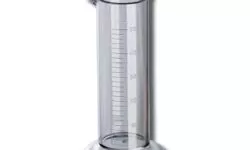
LABORATORY TEST TUBE: Definition, Use and Price
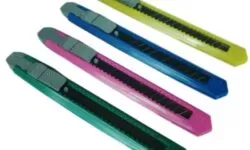
SCHOOL SCALPEL

WASH BOTTLE: Definition, Use and Capacity
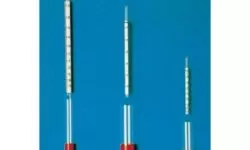
DENSIMETER: Use, Types, Functions and Price

TANITA SCALE: Prices and Offers
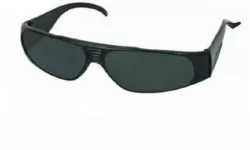
SAFETY GOGGLES USES
Other Products of Interest in ALPHAPEDIA

WOODEN GARDEN BENCHES: Great Price on Qualified Products

INDOOR FLY SPRAY PRICE
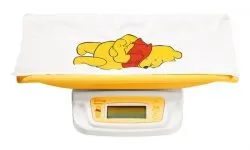
BABY SCALES: Definition, Price and Types

ACCUWEIGHT SCALE: Prices and Reviews on Amazon
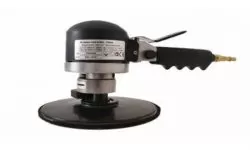
ORBITAL SANDER: Great Price on Qualified Products

WOODEN BAR STOOLS: Great Price on Qualified Products
Other Topics of Interest in ALPHAPEDIA

FREE MASTER DEGREE IN PERFORMING ARTS

FREE BACHELOR OF AYURVEDA DEGREE
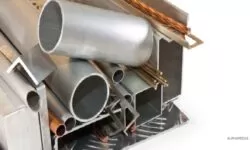
FERROUS AND NON FERROUS METALS

DOCTORATE IN ARCHITECTURE

FREE ARCHIVES COURSE

FREE ONLINE CHIROMASSAGE COURSE
Image, Photo for Drawing of Magnetic Stirrer
